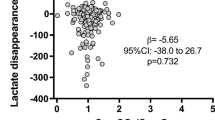Abstract
Central mixed venous oxygen saturation (S\(\mathop v\limits^ - \)O2) monitoring in critically ill patients to estimate adequacy of peripheral perfusion is gaining increasing popularity. However, a number of unexpected responses, one of which is marked depression of regional (splanchnic) venous oxygen saturation which may coexist with normal or high S\(\mathop v\limits^ - \)O2, makes interpretation pretation of this parameter difficult. The S\(\mathop v\limits^ - \)O2 and hepatic venous oxygen saturation levels in seven injured (postoperative) and 15 septic patients were measured. No substantial differences between central and hepatic venous oxygen saturation were noted in nonseptic patients, however, septic subjects exhibited a normal S\(\mathop v\limits^ - \)O2 of 70.5%±8.7% at a time when the hepatic venous saturation was 55.6%±14.4% which is a significant (p<0.05) reduction. This reduced oxygen saturation was noted to arise from an increased regional metabolic rate rather than reduced perfusion. Nevertheless, we conclude that a flow limited regional oxygen consumption may potentially exist despite the presence of a normal S\(\mathop v\limits^ - \)O2 in certain patient subgroups such as septic subjects. Therefore, a normal S\(\mathop v\limits^ - \)O2 should not be considered as sole criteria to insure optimal oxygen delivery in critically ill patients.
Similar content being viewed by others
References
Astiz M, Rackow EC, Falk JL, Kaufman BS (1983) Assessment of oxygen utilization in septic shock patients. Crit Care Med 11:250
Birman H, Haq A, Hew E, Aberman A (1984) Continuous monitoring of mixed venous oxygen saturation in hemodynamically unstable patients. Chest 86:753
Danek SJ, Lynch JP, Weg JG, Dantzker DR (1980) The dependence of oxygen uptake on oxygen delivery in the adult respiratory distress syndrome. Am Rev Resp Dis 122:387
Divertie MB, McMichan JC (1984) Continuous monitoring of mixed venous oxygen saturation. Chest 85:423
Fahey PJ, Harris K, Vanderwarf C (1984) Clinical experience with continuous monitoring of mixed venous oxygen saturation in respiratory failure. Chest 86:748
French WJ, Chang P, Forsythe S, Criley JM (1983) Estimation of mixed venous oxygen saturation. Cathet Cardiovasc Diagn 9:25
Fry DE, Pearlstein L, Fulton RL, Polk HC (1980) Multiple system organ failure. Arch Surg 115:136
Gottlieb MW, Sarfeh IJ, Stratton H, Goldman ML, Newell JC, Shah DM (1983) Hepatic perfusion and splanchnic oxygen consumption in patients post injury. J Trauma 23:836
Kandel G, Aberman A (1983) Mixed venous oxygen saturation. Its role in the assessment of the critically ill patient. Arch Intern Med 143:1400
Kasnitz P, Druger GL, Yorra F, Simmons DH (1976) Mixed venous oxygen tension and hyperlactatemia. JAMA 236:570
Krauss XH, Verdouw PD, Hugenholtz PG, Nauta J (1975) Online monitoring of mixed venous oxygen saturation after cardiothoracic surgery. Thorax 30:636
Lee J, Wright F, Barber R, Stanley L (1972) Central venous oxygen saturation in shock. Anesthesiology 36:472
Nelson LD (1986) Continuous venous oximetry in surgical patients. Ann Surg 203:329
Rowell LB (1974) Measurement of hepatic splanchnic blood flow in man by dye techniques, In: Bloomfield DA (ed) Dye curves: the theory and practice of indicator dilution. University Park Press, Baltimore MD
Shah DM, Newell JC, Saba TM (1981) Defects in peripheral oxygen utilization following trauma and shock. Arch Surg 116:1277
Shoemaker WC, Appel P, Bland R (1983) Use of physiologic monitoring to predict outcome and to assist in clinical decisions in critically ill postoperative patients. Am J Surg 146:43
Springer RR, Stevens PM (1979) The influence of PEEP on survival of patients in respiratory failure. Am J Med 66:196
Wilmore DW, Goodwin CW, Aulick LH, Powanda MC, Mason AD, Pruitt BA (1980) Effect of injury and infection on visceral metabolism and circulation. Ann Surg 192:491
Author information
Authors and Affiliations
Rights and permissions
About this article
Cite this article
Dahn, M.S., Lange, M.P. & Jacobs, L.A. Central mixed and splanchnic venous oxygen saturation monitoring. Intensive Care Med 14, 373–378 (1988). https://doi.org/10.1007/BF00262891
Received:
Accepted:
Issue Date:
DOI: https://doi.org/10.1007/BF00262891




